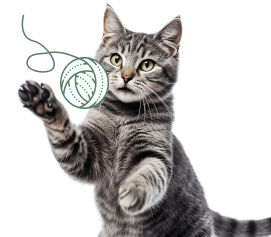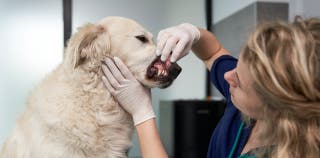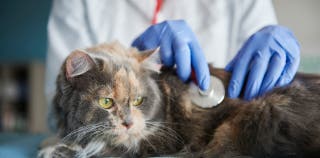- Our top choice for pet insurance that pays the vet directly is Paw Protect, as it’s the easiest to use and offers great coverage at an affordable price.
- There are 5 main pet insurers that can pay the vet directly for you: Paw Protect, Pets Best, Healthy Paws, CarePlus by Chewy, and Trupanion.
- Direct-pay pet insurance will pay your vet’s office on your behalf, meaning you don’t have to pay up-front, submit a claim, and wait to be reimbursed by your pet insurance provider.
Featured direct pay pet insurance offers
Paw Protect

Healthy Paws Pet Insurance

CarePlus by Chewy

What is vet direct-pay insurance?
Direct-pay pet insurance pays the vet bill directly for you instead of making you pay out of pocket and wait to be reimbursed. If a pet insurance provider does not offer vet direct-pay, you have to pay the vet bill upfront, submit a claim for reimbursement, and wait to be reimbursed by check or direct deposit.
How does vet direct-pay work?
While not overly common in the pet insurance industry yet, a few pet insurance providers are at the forefront and offer a solution for paying the vet’s office directly on your behalf. Those companies are Paw Protect, CarePlus by Chewy, Healthy Paws, Pets Best, and Trupanion.
Each pet insurance company has a different method for paying the vet directly. Each method has differing levels of complexities. How each provider pays your vet is important to consider, as some are quite complicated, while others, like Paw Protect, are super easy.
| Company | Method for Paying Vet Directly | Level of Difficulty |
|---|---|---|
| Paw Protect | Paw Protect issues you a $2,000 interest-free line of credit via a prepaid visa you use to pay the vet bills. | Very Easy |
| CarePlus by Chewy | Only applies to plans backed by Trupanion and uses Trupanion’s vet software system. (Roughly 20% of vets have this) | Easy – if vet has software |
| Healthy Paws | Healthy Paws will pay the vet directly, but you must call and get it approved before treatment. | Moderate |
| Pets Best | You need your vet to agree to signing a direct reimbursement waiver and submit it to Pets Best. | Complex |
Does direct-pay instantly pay your vet bill?
Some pet insurance plans like Paw Protect offer direct payment at checkout, and your insurance company will pay the bill within a few seconds or minutes of your visit. Though this type of payment is nearly instantaneous, you may have to make a co-payment or meet a deductible first.
That said, not all companies offer direct payment at checkout. Some companies like Pets Best pay your vet via reimbursement, meaning your vet will receive payment within a few days or weeks of your visit. Usually this type requires previous authorization from your vet.
Our picks for the best pet insurance plans that pay the vet directly
Paw Protect
Why We Like It
Editor's take
Paw Protect is the best choice if you are looking for pet insurance that pays vets directly and won’t leave you with out-of-pocket expenses. It is the only pet insurance provider that offers customers a $2,000 interest-free line of credit you use to pay the vet. Most other providers require you to pay upfront yourself and be reimbursed later after submitting a claim.
Paw Protect offers an accident & illness plan as well as an optional Wellness add-on. Like some other providers, it comes with 24/7 telemedicine coverage which allows you to speak to a vet in case you have an emergency and aren’t sure whether to take your animal in for a visit. It also offers considerable discounts if you have multiple pets (10% off) or are a military member (5% off).
Paw Protect accident and illness plan has a two-day waiting period for accidents and a 14-day waiting period for illnesses. There is a six-month waiting period for canine orthopedic conditions, which can be reduced to 14 days if you complete an orthopedic exam and waiver process.
PROS
- Unlimited coverage option
- Wellness plan add-on available
- Pays vet directly
CONS
- Max age for full coverage
- Doesn’t cover boarding
Healthy Paws Pet Insurance
Why We Like It
Editor's take
Healthy Paws does offer direct vet payment, but it’s not as straightforward as Paw Protect’s line of credit. Healthy Paws plans operate like traditional pet insurance, where you pay the vet and submit your claim to be reimbursed. To have them pay the vet directly, you must contact them prior to the vet appointment to receive approval. Healthy Paws is a great option if you anticipate having claims higher than $2,000.
Being approved for direct payment does not guarantee your claim will be covered, and you could end up being responsible for the cost of the procedure. It’s important to review your policy details ahead of time and consult Healthy Paws directly if you have questions regarding your coverage.
Healthy Paws offers a wide range of coverage options and deductibles, which makes it easy to customize your policy to fit your needs and budget. They offer only an accident & illness plan with unlimited coverage but don’t offer any wellness options. This company is especially affordable for cat parents, with some plan options only costing around $10 a month!
With the Healthy Paws accident and illness plan there’s a 15-day waiting period for accidents and illness and a 12-month waiting period for conditions linked to hip dysplasia or if your pet is under the age of six.
PROS
- Unlimited coverage
- Affordable plans
- Five reimbursement levels to choose from
CONS
- Max age limit for enrollment
- Doesn’t cover dental disease
- No wellness add-on available
CarePlus by Chewy
Why We Like It
Editor's take
CarePlus by Chewy offers vet direct pay if you have one of their more comprehensive plans. CarePlus partners with Trupanion and Lemonade to administer their policies, with the value plans coming through Lemonade and the more comprehensive plans through Trupanion. If you have one of the Trupanion plans through CarePlus, you can set up vet direct pay with any vet that works with the Trupanion system.
The vet only needs your policy number to submit the claim for you, then they directly receive the payment. Pet owners are only responsible for their deductible and copay. If you are planning to use direct pay, talk to your vet’s office prior to your appointment to make sure they are partnered with Trupanion and to understand their direct payment policies. You can use your CarePlus pet insurance at any vet nationwide, but not all offices will have the option to pay the vet directly.
CarePlus is one of the only companies that offer up to 100% reimbursement for prescription products. There is no maximum age of enrollment and it offers unlimited coverage limits. You’ll get access to telemedicine via chat/video which gives you free vet consultations for non-emergency topics.
Depending on the plan you choose, you will have a 2-5 day waiting period for accidents, a 14-day waiting period for new illnesses, and either a 14-day, 30-day, or 6-month wait for cruciate ligament conditions.
PROS
- No max enrollment age
- Covers prescription products
- Free online vet consultations
- Wellness plans are available
CONS
- Not all plans cover dental disease
- Higher prices than some insurers
- Won’t cover alternative medicine
Pets Best Insurance
Why We Like It
Editor's take
Pets Best vet direct pay can be used at any vets office as long as they agree to receive payment this way. If they do, you need to submit a reimbursement form (which can be found on Pets Best’s website) along with your claim, and Pets Best will direct the payment to your vet’s office. While your vet doesn’t need to be “in-network” or using any special system, they are not required to accept direct payment and may tell you you need to pay the bill up front. You should always check with your vet ahead of time to see what their direct payment policies are.
We like Pets Best as it offers competitively priced plans with a wide range of deductible options. This is great for people on a budget as it allows you to tailor your plan to what you can afford. There is no age limit for sign-ups, meaning you can purchase coverage for your pet later in life. You’ll also get unlimited access to a 24/7 emergency vet hotline for quick consultations at all hours of the day.
Pets Best offers multiple plans including an Accident-only plan, as well as 3 tiers called Essential, Plus, and Elite. You can also opt for an add-on for wellness / routine care plans for an extra fee which offers good coverage versus other plans on the market.
With Pets Best you can expect a waiting period of 3 days for accidents, 14 days for illnesses, and 6 months for cruciate ligament conditions. When choosing, note that exam fees are not included in the Essential plan, which is why we recommend opting for a higher-tier plan, such as the Elite plan.
PROS
- Unlimited coverage option
- Many deductible options
- No age limit for enrollment
- Vet-direct pay option
CONS
- Doesn’t cover alternative therapies
- Doesn’t cover breed-specific issues
What are the benefits of direct-pay pet insurance?
Direct-pay pet insurance is more convenient for people who don’t want to wait for reimbursement or who may not have funds immediately available to cover the bill on their own.
Pet insurance that pays upfront has the following benefits:
-
Convenience:
With traditional pet insurance, you have to submit a claim every time your pet sees a veterinarian. If you have pet insurance that pays a vet directly, you don’t have to do all the extra paperwork. -
Financial relief:
Not everyone has extra money on hand to cover unexpected vet bills. This type of pet insurance makes it easier to get your pet the care it needs without worrying about running up your credit card balance or draining your savings. -
Seamless care:
If you don’t have to wait for your insurance provider to reimburse you for vet bills, you can make decisions based on what’s best for your pet, not on what’s best for your wallet. -
Peace of mind:
Pet insurance that pays up front gives you extra peace of mind by covering a large portion of your pet’s eligible vet bills. With the right pet insurance, it’s easier to afford accident-related and illness-related veterinary expenses.
These benefits help to make the cost of your pet insurance worth it.
Which companies offer pet insurance that pays the vet directly?
These five pet insurance companies offer direct pay plans:
Paw Protect
Paw Protect is newer to the market and has taken this area by storm. It offers customers the option of a $2,000 interest-free line of credit via a virtual Visa card called Paytient. This allows customers to pay vet bills up-front with an allowance fund from Paw Protect.
It’s done through your phone like Apple Pay, and as it’s a Visa, it’s accepted at almost any vet. There aren’t any credit checks to get approved for it. You can also pay off your out-of-pocket expenses like copay and deductible over up to 12 months, with no interest or fees.
Although Paw Protect doesn’t require you to see a specific vet, if your vet doesn’t have a participating Visa payment terminal, you won’t be able to use Paw Protect for direct payment. You’ll have to pay out of pocket and submit a claim for reimbursement.
Learn more from our Paw Protect review.
Healthy Paws
Healthy paws can pay the vet directly for you, but you must request payment in advance. Essentially, they require authorization before treating the animal, which can be a bit of a pain. The company’s claims team only works during normal business hours, so this can also affect your ability to make a direct vet payment in the evening or on weekends.
Healthy Paws works with any licensed veterinarian, so you don’t have to worry about choosing an in-network vet or getting billed for out-of-network expenses. That said, you remain responsible for all charges until the insurance company reimburses your vet. If a claim is denied, you’ll have to pay the bill yourself.
Learn more from our Healthy Paws Pet Insurance review.
Pets Best
Although not well-known, Pets Best offers a direct pay option that works much like standard pet insurance. After each visit, you submit a claim via the company’s online portal. Instead of reimbursing you, Pets Best reimburses your vet for all eligible expenses. Before you use this option, your vet’s office must fill out a waiver form agreeing to be paid by Pets Best instead of from you directly at the time of service.
Learn more from our Pets Best Pet Insurance review.
CarePlus by Chewy
CarePlus by Chewy is unique in the sense that all of its plans are offered through other insurance providers. Depending on the plan you choose it may be through a provider like Trupanion or another. Essentially, CarePlus acts as a sort of middle man. As a result, if the plan you choose is provided by Trupanion, you can have the option of Trupanion’s vet direct-pay solution. If not, then you won’t have direct pay as an option.
Learn more from our CarePlus by Chewy review.
Trupanion
Trupanion was the first company to test paying the vet directly and invented a software called Trupanion Express to make this possible. When you’re at the vet’s office and ready to pay the bill, the claim is paid directly by Trupanion to the vet. Therefore, the customer is not involved in the transaction and pet owners are only responsible for their deductible and copay.
However, for this to work, the vet must have Trupanion’s software, and the number of vets in the US who have it is around 20% nationwide. If you use a vet that hasn’t opted into Trupanion Express, you’ll have to submit your own claims. Trupanion doesn’t cover routine expenses, including exam fees, wellness checkups, or flea and tick prevention.
Trupanion has no per-condition limits, per-incident limits, annual coverage limits or lifetime limits. However, there is an age limit. You must enroll your pet before it turns 14, or else it won’t be eligible for Trupanion coverage. If you have senior pets, check out our guide to finding pet insurance for older dogs and cats.
Which is the best direct-pay pet insurance?
Our top choice for direct-pay pet insurance is Paw Protect.
We like this option best because you don’t have to mess with difficult waivers or authorizations. We also like that you are pre-approved with a line of credit and can use it whenever you need. That said, it may not be the best option for everyone.
At the end of the day, the best direct-pay pet insurance depends on what type of pet you have, how much you can afford to spend and whether your vet agrees to accept your coverage.
Therefore, before deciding, we recommend you check the terms of each provider to determine the best fit for your needs.
In addition to choosing the best coverage levels, you’ll also want to consider the following factors when choosing a policy:
Premiums
Your monthly premium is the amount you’ll have to pay your insurance company for your policy. The cost of pet insurance can vary widely depending on your coverage levels, your pet’s age and health, and various other factors.
Copay
A copay is a fixed amount you pay toward each covered veterinary service. For example, if your plan has a $20 copay for each visit, you must pay $20 out of pocket before the insurance covers the rest.
Deductibles
Like human health insurers, pet health insurance companies often build a deductible into each plan. The deductible is the amount of money you have to pay toward your pet’s bills before your insurance coverage kicks in.
Waiting periods
Many pet insurance plans also have waiting periods. A waiting period is the amount of time you must wait between the moment you purchase a policy and the time the policy goes into effect. If your pet insurance policy has a 14-day waiting period, then it won’t cover any vet bills until 14 days after you make your first premium payment.
For help finding the right insurance for your pet, you can also:
- Check out our guide on the best pet insurance plans
- Get specific recommendation for dog insurance or cat insurance.
- Head to our cheap pet insurance guide for advice on finding affordable pet insurance
- Use our online comparison tool to compare multiple policies at once
 Join the over 2,438,795+ insured cats & dogs across the US
Compare pet insurance plans & prices from top providers in minutes
COMPARE QUOTES
Join the over 2,438,795+ insured cats & dogs across the US
Compare pet insurance plans & prices from top providers in minutes
COMPARE QUOTES

What if I need help with my vet bills?
Pet insurance gives you extra peace of mind, but it doesn’t cover everything.
For example, many plans don’t cover exam fees and other routine expenses unless you pay for a wellness add-on. Some policies also have a payout limit, which limits the total amount of money the insurer pays out for covered expenses.
It’s also common for pet insurance companies to exclude preexisting conditions from their policies. A preexisting condition is a health problem that exists before you purchase pet insurance. For example, if your dog shows signs of hip dysplasia before you sign up for coverage, there’s a good chance the policy won’t cover any expenses related to hip dysplasia treatment.
If you need help paying veterinary expenses that pet insurance companies just won’t cover, you have a few options.
The Onyx and Breezy Foundation
The Onyx and Breezy Foundation provides grants to pet owners who need help paying veterinary expenses. Before you can apply for a grant, you must apply for Care Credit, a medical credit card. If you don’t qualify for Care Credit, you must include the denial letter with your application. If you’re approved, you must provide a copy of the approval letter to show that your credit limit is less than you need to pay your pet’s expenses.
Required documents
When applying for a grant through The Onyx and Breezy Foundation, you must also provide the following:
- Tax return
- Pet’s diagnosis and prognosis
- Estimate of treatment costs
Waggle
Waggle is a crowdfunding platform specifically for pet owners and animal rescue groups. If pet insurance companies won’t cover your veterinary bills, try creating a Waggle campaign. You must submit your veterinarian’s contact information, an estimate of your pet’s treatment expenses and several photos of your pet.
Once Waggle approves your campaign, you’ll be able to post the link on social media, making it easier to raise funds. For best results, make sure you submit compelling photos. If a donor has to choose between your pet and someone else’s, a good photo may draw their attention to your beloved dog or cat.
The Pet Fund
The Pet Fund provides financial assistance directly to pet owners. To qualify, your pet must need non-basic, non-emergent care. This means that The Pet Fund doesn’t cover routine dental care, spaying, neutering or treatment for broken limbs. It does cover treatment for cancer, heart disease and other non-emergent conditions.
If pet insurance companies won’t cover your pet’s bills, send an email to info@thepetfund.com. In the email, describe your pet’s needs as thoroughly as possible. If you meet the organization’s funding criteria, someone will ask you to complete a formal application. Be sure to include your telephone number in case the reviewer has any questions.
GoFundMe
GoFundMe isn’t specifically for pet owners, but it may help you raise money for vet expenses if the pet insurance companies won’t cover your bills. To solicit donations, set up a campaign on the GoFundMe website. If possible, post a copy of your pet’s treatment estimate to help potential donors feel comfortable supporting your cause.
The Magic Bullet Fund
The Magic Bullet Fund provides funds to help pay for chemotherapy or surgery to treat cancer. It doesn’t pay for experimental treatments, euthanasia, palliative care or treatments for other diseases.
Requirements to qualify
To qualify for help from The Magic Bullet Fund, you must meet the following criteria:
- You are the pet’s primary owner.
- Your pet has a cancer diagnosis from a licensed veterinarian, or it has a mass that must be removed surgically to make a cancer diagnosis.
- You have a treatment estimate from your vet.
- Your vet has permission to speak to a representative from the Magic Bullet Fund about your pet’s diagnosis.
Age and weight restrictions
The organization also has the following age and weight limits for pets:
- Cats: Age limit of 15
- Dogs up to 40 pounds: 14 or younger
- Dogs 40 to 80 pounds: 12 or younger
- Dogs 80 to 100 pounds: 10 or younger
- Dogs 100+ pounds: 9 or younger
Required documentation
When you apply, you must provide the following information:
- Most recent tax return
- Supplemental Security Income (SSI) or Social Security Disability Income (SSDI) letter, if applicable
- Diagnostic report showing cancer
- Treatment estimate
- Previous month’s bank statement
- Other financial documents to help demonstrate need, if applicable
RedRover
RedRover is another option of one of the pet insurance plans with direct pay that will cover your pet’s bills. The organization’s Urgent Relief Program provides small grants to help with the treatment of life-threatening injuries and illnesses.
Requirements to qualify
To qualify, you must meet the following criteria:
- Your pet has an injury or illness requiring urgent treatment.
- You have a diagnosis and treatment plan from a veterinary professional.
- Your household income doesn’t exceed $60,000 per year.
- The recommended treatment is likely to have a favorable outcome.
- You must live in the United States.
- You must agree to provide updates to RedRover if you’re selected for a grant.
 Join the over 2,438,795+ insured cats & dogs across the US
Compare pet insurance plans & prices from top providers in minutes
COMPARE QUOTES
Join the over 2,438,795+ insured cats & dogs across the US
Compare pet insurance plans & prices from top providers in minutes
COMPARE QUOTES

Direct-pay pet insurance FAQs
What is vet direct pay?
This type of pet insurance pays the vet directly so you don’t have to pay out-of-pocket, submit a claim, and wait to be reimbursed.
How does reimbursement typically work with pet insurance?
Traditionally, you pay out of pocket for each vet visit, submit a claim and then wait for your insurer to send you a check or deposit money into your bank account. Paw Protect, CarePlus, Healthy Paws, Pets Best, and Trupanion have direct payment options, allowing you to use your pet insurance at the point of service.
Do all vets take pet insurance?
Not all vets are set up to accept direct payments from pet insurance providers. For example, Trupanion only works with certain payment processors. If your vet doesn’t use one of those processors, they won’t be able to accept direct payments. You can still use your insurance, but you’ll have to file your own claim and wait for reimbursement.










































